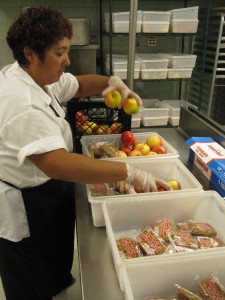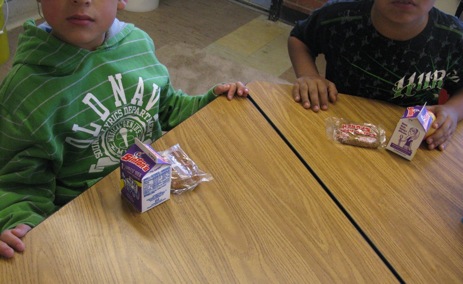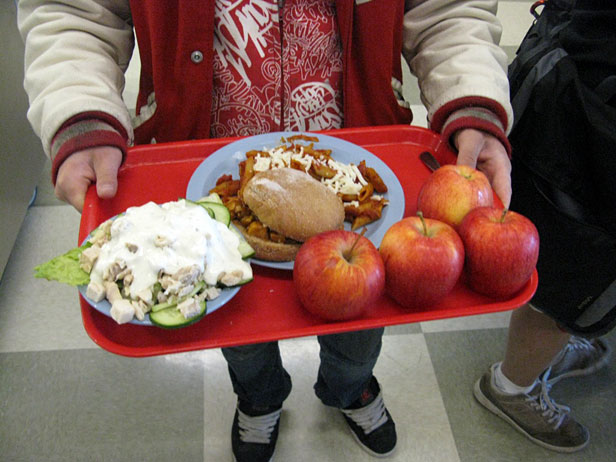Intrepid school-lunch reporter and parent-turned-school-food-activist Ed Bruske has hit the road again, this time traveling to Boulder, Colo. Check out Ed’s previous reporting on Washington, D.C. and Berkeley, Calif. public schools’ food at the Cafeteria Confidential: Behind the Scenes in School Kitchens series homepage.
 Margaret Trevarton, packing breakfast.Photo: Ed BruskeI arrived at Boulder’s Columbine Elementary School at 7 a.m. sharp. Margaret Trevarton, the school’s “kitchen satellite lead” — formerly known as “kitchen manager” — was already packing breakfast for the schools’ 408 students.
Margaret Trevarton, packing breakfast.Photo: Ed BruskeI arrived at Boulder’s Columbine Elementary School at 7 a.m. sharp. Margaret Trevarton, the school’s “kitchen satellite lead” — formerly known as “kitchen manager” — was already packing breakfast for the schools’ 408 students.
Columbine is one of five schools in Boulder where breakfast is universally free and served in the classroom. On this day, Trevarton would be loading each of 22 blue plastic packing boxes, representing all of the school’s classes, with apples, cartons of low-fat milk, and a breakfast bar called “Cherry Apple Crunch.”
The federal government pays schools $1.76 for each breakfast they serve to a student who qualifies for a free meal based on family income, and $1.46 for each student who qualifies for a reduced-price breakfast. Schools with high enrollment of low-income children, such as Columbine, where nearly 80 percent are Hispanic, thus net more funds if breakfast is served to everyone, as they most assuredly are when breakfast is served in the classroom.
Increasingly, schools see breakfast in the classroom as a way of making sure that students are focusing on their studies, instead of on the rumbling in their empty stomachs. And as I wrote when I spent a week in Berkeley schools, a “universal breakfast” strategy can help pay for lunch when a school district is populated by a high percentage of low-income students. In Boulder, only 18 percent of students qualify for free or reduced-price meals, which helps explain why breakfast is served in the classroom in only five of the district’s 48 schools.
Still, I wanted to see how this was done. So I tagged along as Trevarton went about her business, first covering several tables in the cafeteria with plastic containers and filling those with the milk, the apples, the breakfast bars, then loading these into the blue bins, then trucking the bins around the school on a flatbed trolley.
Trevarton is a relative newcomer to the Boulder kitchens. Previously, she was home-schooling her teenage daughter when the daughter essentially pushed her out of the house.
“She was taking courses online and didn’t want me around,” Trevarton explains. She found a job as a “nutritional assistant” at Columbine, and quickly moved up to cook. An avid cook at home, she keeps some 800 family recipes on an Excel spreadsheet. “I knew this was something I could do.”
Now she manages the kitchen, working 5.5 hours each day. “We’re all part-time around here,” she says.
As I would soon learn, filling the breakfast bins involves a lot of stooping and lifting. Trevarton makes fairly quick work of it. She has her system down.
 Simple breakfast.Photo: Ed BruskeSome parents have expressed concern about breakfast served in the classroom cutting into valuable instructional time. At Columbine, the start of the school day was moved up 15 minutes, from 8:30 to 8:15, to make extra time for the morning meal. Still, some teachers allow the children to eat while they proceed with their lessons. Many schools report that when breakfast is served in the classroom, children are less apt to act out, and that absenteeism and visits to the school nurse drop.
Simple breakfast.Photo: Ed BruskeSome parents have expressed concern about breakfast served in the classroom cutting into valuable instructional time. At Columbine, the start of the school day was moved up 15 minutes, from 8:30 to 8:15, to make extra time for the morning meal. Still, some teachers allow the children to eat while they proceed with their lessons. Many schools report that when breakfast is served in the classroom, children are less apt to act out, and that absenteeism and visits to the school nurse drop.
“There’s been a lot of positive feedback that the kids have better attention spans and fewer behavioral problems,” Trevarton said.
I followed Trevarton as she rolled her cart through the school’s hallways, depositing the blue bins outside the classroom doors. As the children arrived and settled into their classrooms, teachers brought the bins inside and distributed the milk, the apples, and the bars.
Inside each bin is a sheet of paper listing the children assigned to that particular class. The teacher marks the children who take the meal, which usually means all of them. Later, Trevarton or one of her kitchen assistants will enter the information in their computer, data that later will be sent to the USDA as part of Boulder’s request for reimbursement under the school meal program.
Inside the classrooms, I see the children contentedly eating their breakfast. Some don’t finish the entire meal, but save it for later.



